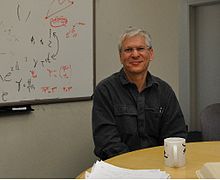Stephen Shenker
Stephen Hart Shenker (* 1953 in Alexandria (Virginia) ) is an American theoretical physicist.
He is the son of the physicist Henry Shenker (1917-2004), who worked at the US Naval Research Laboratories in Washington. Shenker studied at Harvard University (Bachelor 1975) and received his PhD from Cornell University in 1980 with John Kogut and Kenneth Wilson . He was a post-doc at the University of California, Santa Barbara . From 1981 he was at the University of Chicago , where it came to his collaboration with Daniel Friedan on conformal field theories and string theory . From 1989 he was a professor at Rutgers University (like Friedan, with whom he was involved in founding the New High Energy Theory Center ). In 1998 he went to Stanford University as a professor , where he was director of the Institute for Theoretical Physics until 2008. Since 2004 he has been Richard Herschel Weiland Professor in the School of Humanities and Sciences there .
With Zongan Qiu (his PhD student) and Daniel Friedan , he classified two-dimensional unitary conformal field theories in 1984 that have application in statistical mechanics. With Friedan he also dealt with string theory in the mid-1980s, especially with the formulation as conformal field theory on the Worldsheet. In 1997, together with Tom Banks , Willy Fischler and Leonard Susskind, he developed the matrix model as a non-perturbation-theoretical formulation of string theory and M-theory.
In 1979 Shenker investigated the phase structure of Yang Mills theories with Eduardo Fradkin . Most recently he has been working on quantum gravity with applications in cosmology and on the interior of black holes .
In the 2010s he dealt with the hypothesis of the equivalence of certain wormholes between black holes and quantum entanglement (EPR-ER hypothesis by Juan Maldacena and Leonard Susskind ) and chaos theory in both quantum field theory and black holes (in conjunction with his PhD student Douglas Stanford ).
In 1982 he became a Sloan Research Fellow and in 1985 he received the Presidential Young Investigator Award from the National Science Foundation . In 1987 he was a MacArthur Fellow . In 2010 he and Friedan received the Lars Onsager Prize of the American Physical Society . He is a Fellow of the American Physical Society (2003) and the American Academy of Arts and Sciences (2006). In 2015 he was elected to the National Academy of Sciences .
His brother Scott Shenker (* 1956) is a computer scientist, but also worked in theoretical physics.
Web links
- Stephen Shenker, profile. Institute for Theoretical Physics, Stanford University(English).
- 2010 Lars Onsager Prize Recipient Stephen Shenker. APS(English).
- Literature by and about Stephen Shenker in the WorldCat bibliographic database
Individual evidence
- ↑ a b Stephen H. Shenker. In: Member Directory, National Academy of Sciences. Accessed December 2, 2018 .
- ^ Henry Shenker Experimental Physicist. In: Obituaries, Washington Post. October 10, 2004, accessed December 2, 2018 .
- ↑ He received his doctorate in Chicago in 1986. Currently (2010) he is an Associate Professor at the University of Florida . Homepage
- ^ Daniel Friedan, Zongan Qiu, Stephen Shenker: Conformal Invariance, Unitarity, and Critical Exponents in Two Dimensions . In: Physical Review Letters . tape 52 , no. 18 , April 30, 1984, pp. 1575-1578 , doi : 10.1103 / PhysRevLett.52.1575 .
- ↑ T. Banks, W. Fischler, SH Shenker, L. Susskind: M theory as a matrix model: A conjecture . In: Physical Review D . tape 55 , no. 8 , April 15, 1997, p. 5112-5128 , doi : 10.1103 / PhysRevD.55.5112 , arxiv : hep-th / 9610043 .
- ↑ Eduardo Fradkin, Stephen H. Shenker: Phase diagrams of lattice gauge theories with Higgs fields . In: Physical Review D . tape 19 , no. 12 , June 15, 1979, pp. 3682-3697 , doi : 10.1103 / PhysRevD.19.3682 .
- ↑ Stephen Shenker, Physicist, Class of 1987. MacArthur Foundation, accessed December 2, 2018 .
- ↑ 2010 Lars Onsager Prize Recipient Stephen Shenker. APS, accessed on December 2, 2018 .
| personal data | |
|---|---|
| SURNAME | Shenker, Stephen |
| ALTERNATIVE NAMES | Shenker, Stephen Hart (full name) |
| BRIEF DESCRIPTION | American theoretical physicist |
| DATE OF BIRTH | 1953 |
| PLACE OF BIRTH | Alexandria (Virginia) |
